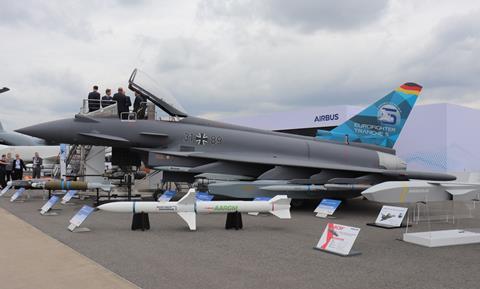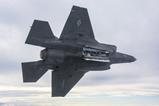The four-nation Eurofighter consortium appears to be close to securing another order boost from one of its partner countries, with Italy expected to announce a follow-on commitment in the near future.
If confirmed, the acquisition – likely to be for 24 of the multirole combat aircraft – would follow German Chancellor Olaf Scholz’s surprise announcement of a 20-unit purchase for the Luftwaffe on the opening day of the ILA Berlin air show on 5 June.
The Italian air force requirement is to acquire new fighters to replace its oldest Tranche 1-standard examples.

“We have clear signs that Eurofighter is still at the heart of European defence – this is true not only for industry, but also for the users,” Leonardo co-general manager Lorenzo Mariani said at the show on 6 June. “The aircraft is still a key component of the air defence backbone of Europe and NATO.”
Of the remaining partner nations, Spain also is expected to place a future ‘Halcon II’ order for additional Eurofighters, with only the UK to not take more Typhoons.
While such deals will boost manufacturing, fresh international success will also be key to extending production until European industry starts building a new breed of sixth-generation fighters.
“Eurofighter is seeing a golden moment also in terms of export,” Mariani says, with potential customers including Poland, Saudi Arabia and Turkey, along with other current users who might look to add to their in-service fleets.
Also supporting the programme momentum is a newly agreed programme of upgrades – the P4E package was approved by the partner nations via the NATO Eurofighter and Tornado Management Agency.
Announced on the opening day of the biennial show, the P4E system definition advance will lead to a raft of enhancements, among them “an automated sensor management capability for all Typhoon radars… reducing the pilot workload required as they manage different sensors”.
P4E also will deliver an improved cockpit interface, defensive aids sub-system upgrades, and additional electronic warfare capability for German aircraft.
It also paves the way for a future Long-Term Evolution activity which will add new capabilities to the type, potentially including some technologies pulled forward from the Italian-Japanese-UK Global Combat Air Programme (GCAP) and the Future Combat Air System activity between France, Germany and Spain.
“From Typhoon to GCAP is quite a wise approach regarding whether you can insert new technologies in the next five or six years,” Mariani says. This could include exploring aspects such as multi-domain integration and the ability to team with ‘loyal wingman’-type platforms, he suggests.
Referring to final assembly work performed by Leonardo, he says the completion of output for Kuwait, the pending Italian follow-on deal and further export business “should make a seamless transition to GCAP”. The three-nation programme is aiming to introduce an operational capability for use from 2035.































